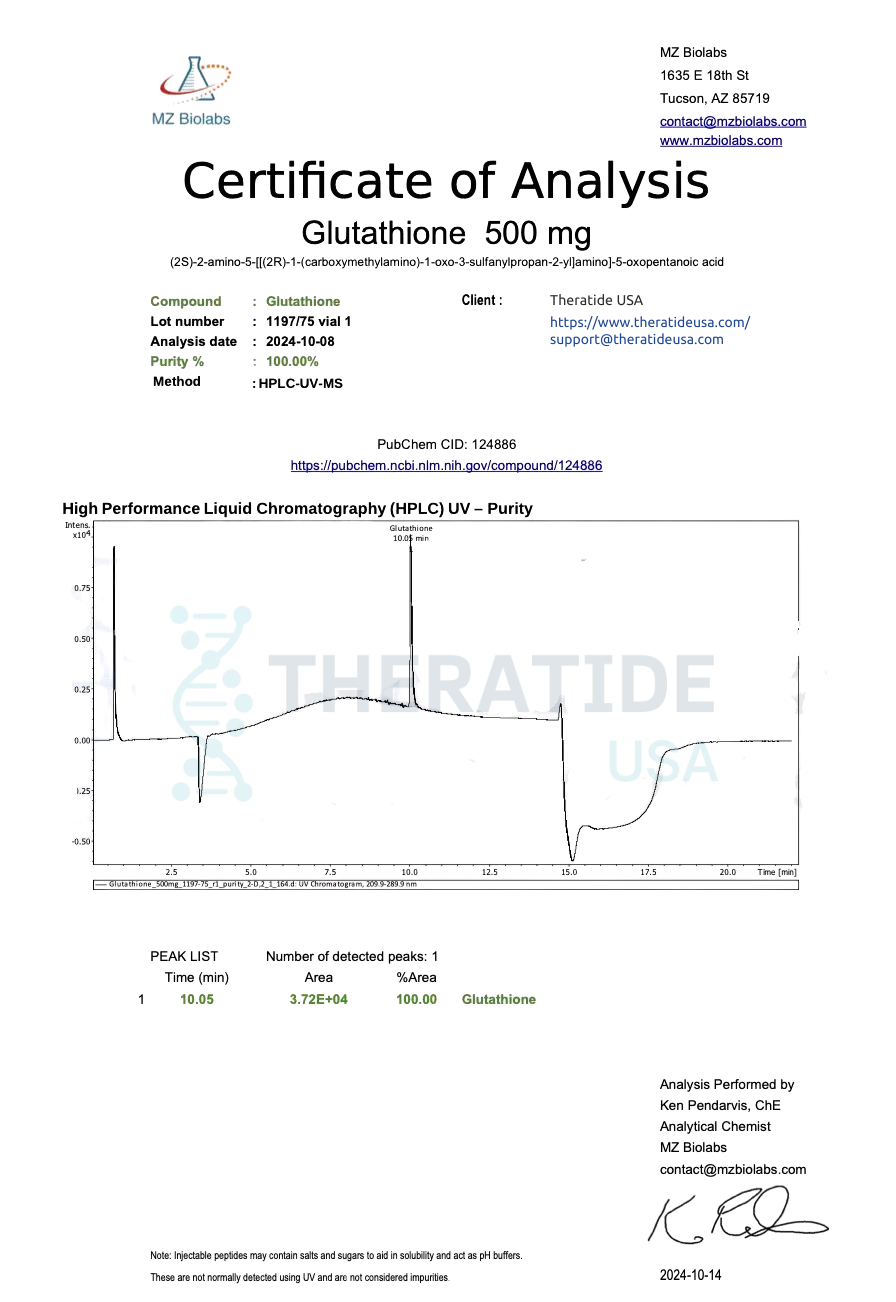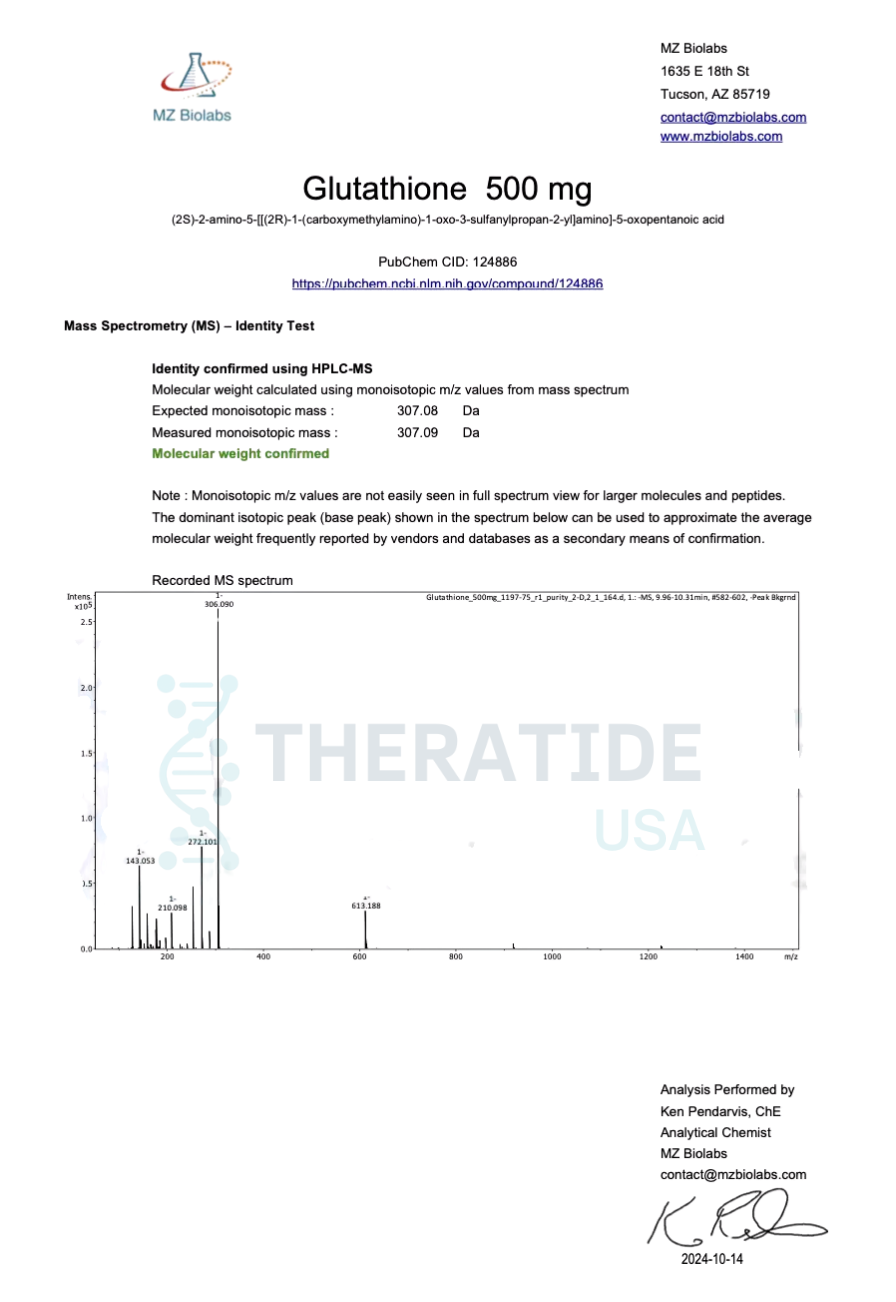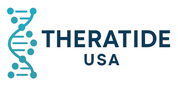Product Overview
Product Overview
What Is L-Glutathione?
L-Glutathione is a tripeptide composed of glutamate, cysteine, and glycine, and is one of the most important low-molecular-weight antioxidants naturally produced in human tissues. It plays a central role in maintaining cellular homeostasis by neutralizing free radicals, supporting detoxification pathways, protecting DNA and proteins from oxidative stress, and regulating a multitude of biochemical processes. Found in high concentrations in the brain, liver, lungs, and retina, glutathione also contributes to the proper functioning of the immune system and helps maintain healthy cellular function during periods of stress or aging.
Glutathione and Eye Health
Glutathione is critical for maintaining lens clarity and retinal health. It helps protect the lens from oxidative damage and prevents the formation of cataracts by preserving the reduced state of protein thiols in the eye. Animal studies show that glutathione supplementation—particularly via topical (eye drop) or inhalation routes—can reduce age-related oxidative stress, slow cataract progression, and protect visual acuity [13][14][15].
Glutathione and Cartilage Health
Glutathione also plays an important role in maintaining cartilage resilience to oxidative stress, which is essential in preventing and managing osteoarthritis. While supplementation improves glutathione levels in cartilage, research also highlights the importance of mechanical unloading and exercise in restoring optimal levels and reducing age-related degeneration [16].
Glutathione and Skin
Studies demonstrate that glutathione supplementation can reduce the outward signs of skin aging by improving elasticity, reducing wrinkles, and lightening hyperpigmentation by inhibiting melanin synthesis. It also contributes to fewer age spots, a more even skin tone, and may lower the incidence of certain skin cancers by mitigating UV-induced damage [17][18].
Glutathione and the Immune System
The immune system is exceptionally sensitive to glutathione status. While supplementation has little effect during healthy states, it provides significant benefit during disease, infection, or oxidative stress by increasing natural killer cell activity, enhancing lymphocyte proliferation, and improving immune resilience. Maintaining sufficient glutathione levels may help the immune system respond more effectively to challenges [19][20].
Molecular Structure of L-Glutathione

Molecular Formula: C10H17N3O6S
Molecular Weight: 307.32 g/mol
CAS Number: 70-18-8
Synonyms: GSH, Reduced Glutathione
Referenced Citations
- Forman et al., “Glutathione: overview of its protective roles, measurement, and biosynthesis,” Mol. Aspects Med., 2009.
- Teskey et al., “Glutathione as a Marker for Human Disease,” Adv. Clin. Chem., 2018.
- Tsunoda et al., “Intact protein folding in the glutathione-depleted endoplasmic reticulum,” eLife, 2014.
- Hudson et al., “Oxidative protein folding,” Free Radic. Biol. Med., 2015.
- Freitas & Reis, “Glutathione induces GABA release,” Neurogenesis, 2017.
- Wu & Batist, “Glutathione and analogues,” Biochim. Biophys. Acta, 2013.
- Nagapan et al., “Oral supplementation of L-glutathione prevents UV-induced melanogenesis,” Exp. Anim., 2019.
- Bansal & Simon, “Glutathione metabolism in cancer progression,” J. Cell Biol., 2018.
- Traverso et al., “Role of glutathione in chemoresistance,” Oxid. Med. Cell. Longev., 2013.
- Homma & Fujii, “Application of Glutathione as Anti-Oxidative and Anti-Aging Drugs,” Curr. Drug Metab., 2015.
- Maher, “The effects of stress and aging on glutathione metabolism,” Ageing Res. Rev., 2005.
- Ganea & Harding, “Glutathione-related enzymes and the eye,” Curr. Eye Res., 2006.
- Reddy, “Glutathione and its function in the lens,” Exp. Eye Res., 1990.
- Reddy & Giblin, “Metabolism and function of glutathione in the lens,” Ciba Found. Symp., 1984.
- Babizhayev, “Nutrition for the aging eye,” Am. J. Ther., 2010.
- Zhu et al., “Glutathione as a Mediator of Cartilage Oxidative Stress Resistance,” Connect. Tissue Res., 2020.
- Weschawalit et al., “Glutathione and its antiaging and antimelanogenic effects,” Clin. Cosmet. Investig. Dermatol., 2017.
- Dilkothornsakul et al., “Glutathione and skin conditions: A review,” J. Cosmet. Dermatol., 2019.
- Dröge & Breitkreutz, “Glutathione and immune function,” Proc. Nutr. Soc., 2000.
- Sinha et al., “Oral supplementation with liposomal glutathione,” Eur. J. Clin. Nutr., 2018.
Disclaimer
ALL ARTICLES AND PRODUCT INFORMATION PROVIDED ON THIS WEBSITE ARE FOR INFORMATIONAL AND EDUCATIONAL PURPOSES ONLY.
The products offered on this website are furnished for in-vitro studies only. In-vitro studies (Latin: in glass) are performed outside of the body. These products are not medicines or drugs and have not been approved by the FDA to prevent, treat or cure any medical condition, ailment or disease. Bodily introduction of any kind into humans or animals is strictly forbidden by law.


Storage Instructions
All of our products are manufactured using the Lyophilization (Freeze Drying) process, which ensures that our products remain 100% stable for shipping for up to 3-4 months. Once the peptides are reconstituted (mixed with bacteriostatic water), they must be stored in the fridge to maintain stability. After reconstitution, the peptides will remain stable for up to 30 days.
Lyophilization is a unique dehydration process, also known as cryodesiccation, where the peptides are frozen and then subjected to low pressure. This causes the water in the peptide vial to sublimate directly from solid to gas, leaving behind a stable, crystalline white structure known as lyophilized peptide. The puffy white powder can be stored at room temperature until you're ready to reconstitute it with bacteriostatic water.
Once peptides have been received, it is imperative that they are kept cold and away from light. If the peptides will be used immediately, or in the next several days, weeks or months, short-term refrigeration under 4°C (39°F) is generally acceptable. Lyophilized peptides are usually stable at room temperatures for several weeks or more, so if they will be utilized within weeks or months such storage is typically adequate.
However, for longer-term storage (several months to years) it is more preferable to store peptides in a freezer at -80°C (-112°F). When storing peptides for months or even years, freezing is optimal in order to preserve the peptide’s stability.
For further information on proper storage techniques, click the link below:





